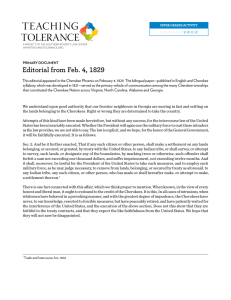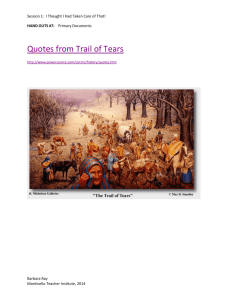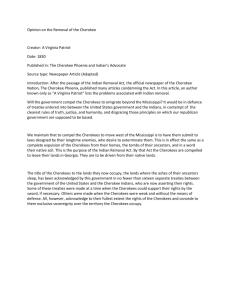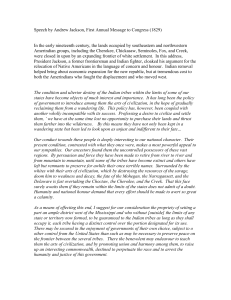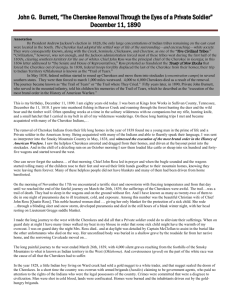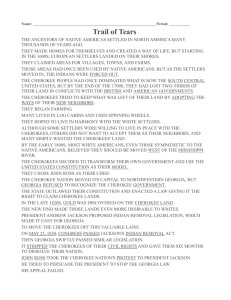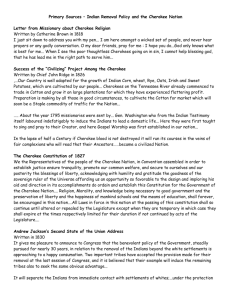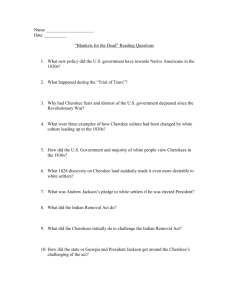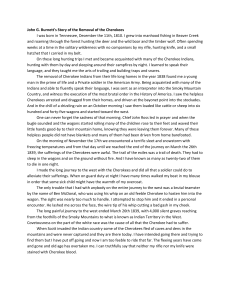trail of tears - the Stowe School District
advertisement
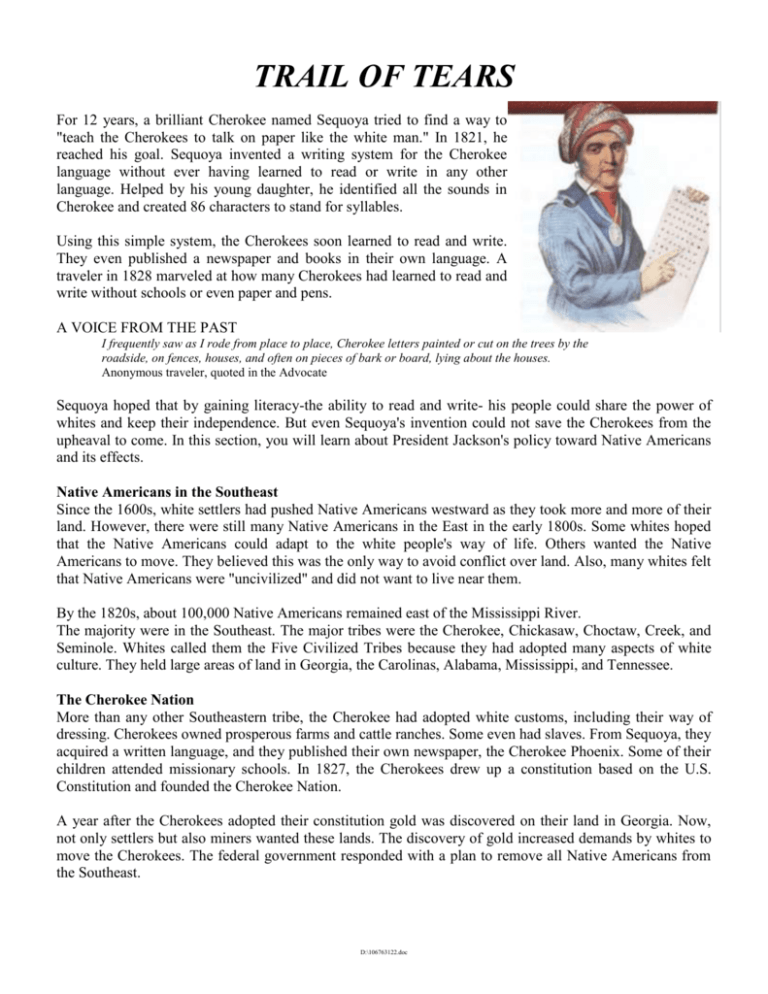
TRAIL OF TEARS For 12 years, a brilliant Cherokee named Sequoya tried to find a way to "teach the Cherokees to talk on paper like the white man." In 1821, he reached his goal. Sequoya invented a writing system for the Cherokee language without ever having learned to read or write in any other language. Helped by his young daughter, he identified all the sounds in Cherokee and created 86 characters to stand for syllables. Using this simple system, the Cherokees soon learned to read and write. They even published a newspaper and books in their own language. A traveler in 1828 marveled at how many Cherokees had learned to read and write without schools or even paper and pens. A VOICE FROM THE PAST I frequently saw as I rode from place to place, Cherokee letters painted or cut on the trees by the roadside, on fences, houses, and often on pieces of bark or board, lying about the houses. Anonymous traveler, quoted in the Advocate Sequoya hoped that by gaining literacy-the ability to read and write- his people could share the power of whites and keep their independence. But even Sequoya's invention could not save the Cherokees from the upheaval to come. In this section, you will learn about President Jackson's policy toward Native Americans and its effects. Native Americans in the Southeast Since the 1600s, white settlers had pushed Native Americans westward as they took more and more of their land. However, there were still many Native Americans in the East in the early 1800s. Some whites hoped that the Native Americans could adapt to the white people's way of life. Others wanted the Native Americans to move. They believed this was the only way to avoid conflict over land. Also, many whites felt that Native Americans were "uncivilized" and did not want to live near them. By the 1820s, about 100,000 Native Americans remained east of the Mississippi River. The majority were in the Southeast. The major tribes were the Cherokee, Chickasaw, Choctaw, Creek, and Seminole. Whites called them the Five Civilized Tribes because they had adopted many aspects of white culture. They held large areas of land in Georgia, the Carolinas, Alabama, Mississippi, and Tennessee. The Cherokee Nation More than any other Southeastern tribe, the Cherokee had adopted white customs, including their way of dressing. Cherokees owned prosperous farms and cattle ranches. Some even had slaves. From Sequoya, they acquired a written language, and they published their own newspaper, the Cherokee Phoenix. Some of their children attended missionary schools. In 1827, the Cherokees drew up a constitution based on the U.S. Constitution and founded the Cherokee Nation. A year after the Cherokees adopted their constitution gold was discovered on their land in Georgia. Now, not only settlers but also miners wanted these lands. The discovery of gold increased demands by whites to move the Cherokees. The federal government responded with a plan to remove all Native Americans from the Southeast. D:\106763122.doc Jackson's Removal Policy Andrew Jackson had long supported a policy of moving Native Americans west of the Mississippi. He first dealt with the Southeastern tribes after the War of 1812. The federal government ordered Jackson, then acting as Indian treaty commissioner, to make treaties with the Native Americans of the region. Through these treaties forced on the tribes, the government gained large tracts of land. Jackson believed that the government had the right to regulate where Native Americans could live. He viewed them as conquered subjects who lived within the borders of the United States. He thought that Native Americans had one of two choices. They could adopt white culture and become citizens of the United States. Or they could move into the Western territories. They could not, however, have their own governments within the nation's borders. After the discovery of gold, whites began to move onto Cherokee land. Georgia and other Southern states passed laws that gave them the right to take over Native American lands. When the Cherokee and other tribes protested, Jackson supported the states. To solve the problem, Jackson asked Congress to pass a law that would require Native Americans to either move west or submit to state laws. Many Americans objected to Jackson's proposal. Massachusetts congressman Edward Everett opposed removing Native Americans against their will to a distant land. There, he said, they would face "the perils and hardships of a wilderness." Religious groups such as the Quakers also opposed forced removal of Native Americans. After heated debate, Congress passed the Indian Removal Act in 1830. The act called for the government to negotiate treaties that would require Native Americans to relocate west. Jackson immediately set out to enforce the law. He thought his policy was "just and liberal" and would allow Native Americans to keep their way of life. Instead, his policy caused much hardship and forever changed relations between whites and Native Americans. The Trail of Tears As whites invaded their homelands, many Native Americans saw no other choice but to sign treaties exchanging their land for land in the West. Under the treaties, Native Americans would be moved to an area that covered what is now Oklahoma and parts of Kansas and Nebraska. This area came to be called Indian Territory. Beginning in the fall of 1831, the Choctaw and other Southeast tribes were removed from their lands and relocated to Indian Territory. The Cherokees, however, first appealed to the U.S. Supreme Court to protect their land from being seized by Georgia. In 1832, the Court, led by Chief Justice John Marshall, ruled that only the federal government, not the states, could make laws governing the Cherokees. This ruling meant that the Georgia laws did not apply to the Cherokee Nation. However, both Georgia and President Jackson ignored the Supreme Court. Jackson said, "John Marshall has made his decision. . . . Now let him enforce it." In 1838, the Cherokees left their homeland by wagon, horse, donkey, and foot, forced to travel hundreds of miles along the Trail of Tears. artist. D:\106763122.doc How does this portrayal of the Trail of Tears reflect continuity and change in 19th-century life? A small group of Cherokees gave up and signed a treaty to move west. But the majority of the Cherokees, led by John Ross, opposed the treaty. Jackson refused to negotiate with these Cherokees. In 1838, federal troops commanded by General Winfield Scott rounded up about 16,000 Cherokees and forced them into camps. Soldiers took people from their homes with nothing but the clothes on their backs. Over the fall and winter of 18381839, these Cherokees set out on the long journey west. Forced to march in the cold, rain, and snow without adequate clothing, many grew weak and ill. One-fourth died. The dead included John Ross's wife. One soldier never forgot what he witnessed on the trail. A VOICE FROM THE PAST Murder is murder and somebody must answer, somebody must explain the streams of blood that flowed in the Indian country in . . . 1838. Somebody must explain the four-thousand silent graves that mark the trail of the Cherokees to their exile. I wish I could forget it all, but the picture of six hundred and forty-five wagons lumbering over the frozen ground with their Cargo of suffering humanity still lingers in my memory. John G. Burnett, quoted in The Native Americans, edited by Betty and Ian Ballantine This harsh journey of the Cherokee from their homeland to Indian Territory became known as the Trail of Tears. Native American Resistance Not all the Cherokees moved west in 1838. That fall, soldiers had rounded up an old Cherokee farmer named Tsali and his family, including his grown sons. On the way to the stockade, they fought the soldiers. A soldier was killed before Tsali fled with his family to the Great Smoky Mountains in North Carolina. There they found other Cherokees. The U.S. Army sent a message to Tsali. If he and his sons would give themselves up, the others could remain. They surrendered, and all except the youngest son were shot. Their sacrifice allowed some Cherokees to stay in their homeland. Other Southeast tribes also resisted relocation. In 1835, the Seminoles refused to leave Florida. This refusal led to the Second Seminole War. One elderly Seminole explained why he could not leave: "If suddenly we tear our hearts from the homes around which they are twined [wrapped around], our heart strings will snap." One of the most important leaders in the war was Osceola (AHS ee OH luh). Hiding in the Everglades, Osceola and his band used surprise attacks to defeat the U.S. Army in many battles. In 1837, Osceola was tricked into capture when he came to peace talks during a truce. He later died in prison. But the Seminoles continued to fight. D:\106763122.doc Some went deeper into the Everglades, where their descendants live today. Others moved west. The Second Seminole War ended in 1842. Some tribes north of the Ohio River also resisted relocation. The Shawnee, Ottawa, Potawatomi, Sauk, and Fox were removed to Indian Territory. But in 1832, a Sauk chief named Black Hawk led a band of Sauk and Fox back to their lands in Illinois. In the Black Hawk War, the Illinois militia and the U.S. Army crushed the uprising. QUESTIONS 1. Explain the significance of Indian Removal Act, Indian Territory, Trail of Tears, 2. How did Jackson justify the Indian removal policy? 3. What were the consequences of the Indian Removal Act? 4. What were some economic effects of the Indian Removal Act on Native Americans? On whites? 5. How did President Jackson react to the U.S. Supreme Court’s decision? What would happen today if the President Obama did the same thing? 6. Cultural groups with limited resources are at risk of being dominated and oppressed by more powerful groups. Use specific examples from the previous units studied this year to support your position. D:\106763122.doc

